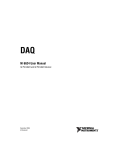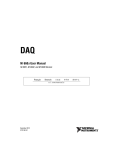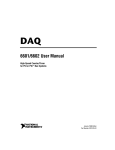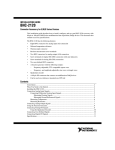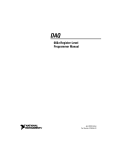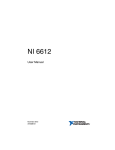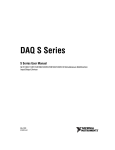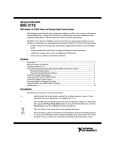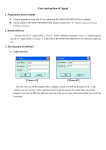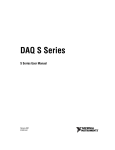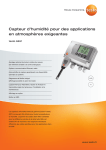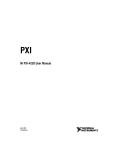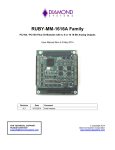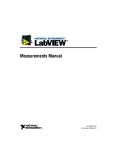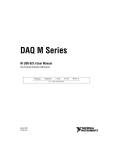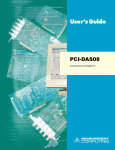Download PCI-660X User Manual
Transcript
DAQ NI 660x User Manual NI 6601, NI 6602, and NI 6608 Devices NI 660x User Manual December 2006 372119A-01 Support Worldwide Technical Support and Product Information ni.com National Instruments Corporate Headquarters 11500 North Mopac Expressway Austin, Texas 78759-3504 USA Tel: 512 683 0100 Worldwide Offices Australia 1800 300 800, Austria 43 0 662 45 79 90 0, Belgium 32 0 2 757 00 20, Brazil 55 11 3262 3599, Canada 800 433 3488, China 86 21 6555 7838, Czech Republic 420 224 235 774, Denmark 45 45 76 26 00, Finland 385 0 9 725 725 11, France 33 0 1 48 14 24 24, Germany 49 0 89 741 31 30, India 91 80 41190000, Israel 972 0 3 6393737, Italy 39 02 413091, Japan 81 3 5472 2970, Korea 82 02 3451 3400, Lebanon 961 0 1 33 28 28, Malaysia 1800 887710, Mexico 01 800 010 0793, Netherlands 31 0 348 433 466, New Zealand 0800 553 322, Norway 47 0 66 90 76 60, Poland 48 22 3390150, Portugal 351 210 311 210, Russia 7 495 783 68 51, Singapore 1800 226 5886, Slovenia 386 3 425 42 00, South Africa 27 0 11 805 8197, Spain 34 91 640 0085, Sweden 46 0 8 587 895 00, Switzerland 41 56 200 51 51, Taiwan 886 02 2377 2222, Thailand 662 278 6777, Turkey 90 212 279 3031, United Kingdom 44 0 1635 523545 For further support information, refer to the Technical Support and Professional Services appendix. To comment on National Instruments documentation, refer to the National Instruments Web site at ni.com/info and enter the info code feedback. © 2006 National Instruments Corporation. All rights reserved. Important Information Warranty The NI 6601, NI 6602, and NI 6608 devices are warranted against defects in materials and workmanship for a period of one year from the date of shipment, as evidenced by receipts or other documentation. National Instruments will, at its option, repair or replace equipment that proves to be defective during the warranty period. This warranty includes parts and labor. The media on which you receive National Instruments software are warranted not to fail to execute programming instructions, due to defects in materials and workmanship, for a period of 90 days from date of shipment, as evidenced by receipts or other documentation. National Instruments will, at its option, repair or replace software media that do not execute programming instructions if National Instruments receives notice of such defects during the warranty period. National Instruments does not warrant that the operation of the software shall be uninterrupted or error free. A Return Material Authorization (RMA) number must be obtained from the factory and clearly marked on the outside of the package before any equipment will be accepted for warranty work. National Instruments will pay the shipping costs of returning to the owner parts which are covered by warranty. National Instruments believes that the information in this document is accurate. The document has been carefully reviewed for technical accuracy. In the event that technical or typographical errors exist, National Instruments reserves the right to make changes to subsequent editions of this document without prior notice to holders of this edition. The reader should consult National Instruments if errors are suspected. In no event shall National Instruments be liable for any damages arising out of or related to this document or the information contained in it. EXCEPT AS SPECIFIED HEREIN, NATIONAL INSTRUMENTS MAKES NO WARRANTIES, EXPRESS OR IMPLIED, AND SPECIFICALLY DISCLAIMS ANY WARRANTY OF MERCHANTABILITY OR FITNESS FOR A PARTICULAR PURPOSE. CUSTOMER’S RIGHT TO RECOVER DAMAGES CAUSED BY FAULT OR NEGLIGENCE ON THE PART OF NATIONAL INSTRUMENTS SHALL BE LIMITED TO THE AMOUNT THERETOFORE PAID BY THE CUSTOMER. NATIONAL INSTRUMENTS WILL NOT BE LIABLE FOR DAMAGES RESULTING FROM LOSS OF DATA, PROFITS, USE OF PRODUCTS, OR INCIDENTAL OR CONSEQUENTIAL DAMAGES, EVEN IF ADVISED OF THE POSSIBILITY THEREOF. This limitation of the liability of National Instruments will apply regardless of the form of action, whether in contract or tort, including negligence. Any action against National Instruments must be brought within one year after the cause of action accrues. National Instruments shall not be liable for any delay in performance due to causes beyond its reasonable control. The warranty provided herein does not cover damages, defects, malfunctions, or service failures caused by owner’s failure to follow the National Instruments installation, operation, or maintenance instructions; owner’s modification of the product; owner’s abuse, misuse, or negligent acts; and power failure or surges, fire, flood, accident, actions of third parties, or other events outside reasonable control. Copyright Under the copyright laws, this publication may not be reproduced or transmitted in any form, electronic or mechanical, including photocopying, recording, storing in an information retrieval system, or translating, in whole or in part, without the prior written consent of National Instruments Corporation. National Instruments respects the intellectual property of others, and we ask our users to do the same. NI software is protected by copyright and other intellectual property laws. Where NI software may be used to reproduce software or other materials belonging to others, you may use NI software only to reproduce materials that you may reproduce in accordance with the terms of any applicable license or other legal restriction. Trademarks National Instruments, NI, ni.com, and LabVIEW are trademarks of National Instruments Corporation. Refer to the Terms of Use section on ni.com/legal for more information about National Instruments trademarks. Other product and company names mentioned herein are trademarks or trade names of their respective companies. Members of the National Instruments Alliance Partner Program are business entities independent from National Instruments and have no agency, partnership, or joint-venture relationship with National Instruments. Patents For patents covering National Instruments products, refer to the appropriate location: Help»Patents in your software, the patents.txt file on your CD, or ni.com/patents. WARNING REGARDING USE OF NATIONAL INSTRUMENTS PRODUCTS (1) NATIONAL INSTRUMENTS PRODUCTS ARE NOT DESIGNED WITH COMPONENTS AND TESTING FOR A LEVEL OF RELIABILITY SUITABLE FOR USE IN OR IN CONNECTION WITH SURGICAL IMPLANTS OR AS CRITICAL COMPONENTS IN ANY LIFE SUPPORT SYSTEMS WHOSE FAILURE TO PERFORM CAN REASONABLY BE EXPECTED TO CAUSE SIGNIFICANT INJURY TO A HUMAN. (2) IN ANY APPLICATION, INCLUDING THE ABOVE, RELIABILITY OF OPERATION OF THE SOFTWARE PRODUCTS CAN BE IMPAIRED BY ADVERSE FACTORS, INCLUDING BUT NOT LIMITED TO FLUCTUATIONS IN ELECTRICAL POWER SUPPLY, COMPUTER HARDWARE MALFUNCTIONS, COMPUTER OPERATING SYSTEM SOFTWARE FITNESS, FITNESS OF COMPILERS AND DEVELOPMENT SOFTWARE USED TO DEVELOP AN APPLICATION, INSTALLATION ERRORS, SOFTWARE AND HARDWARE COMPATIBILITY PROBLEMS, MALFUNCTIONS OR FAILURES OF ELECTRONIC MONITORING OR CONTROL DEVICES, TRANSIENT FAILURES OF ELECTRONIC SYSTEMS (HARDWARE AND/OR SOFTWARE), UNANTICIPATED USES OR MISUSES, OR ERRORS ON THE PART OF THE USER OR APPLICATIONS DESIGNER (ADVERSE FACTORS SUCH AS THESE ARE HEREAFTER COLLECTIVELY TERMED “SYSTEM FAILURES”). ANY APPLICATION WHERE A SYSTEM FAILURE WOULD CREATE A RISK OF HARM TO PROPERTY OR PERSONS (INCLUDING THE RISK OF BODILY INJURY AND DEATH) SHOULD NOT BE RELIANT SOLELY UPON ONE FORM OF ELECTRONIC SYSTEM DUE TO THE RISK OF SYSTEM FAILURE. TO AVOID DAMAGE, INJURY, OR DEATH, THE USER OR APPLICATION DESIGNER MUST TAKE REASONABLY PRUDENT STEPS TO PROTECT AGAINST SYSTEM FAILURES, INCLUDING BUT NOT LIMITED TO BACK-UP OR SHUT DOWN MECHANISMS. BECAUSE EACH END-USER SYSTEM IS CUSTOMIZED AND DIFFERS FROM NATIONAL INSTRUMENTS' TESTING PLATFORMS AND BECAUSE A USER OR APPLICATION DESIGNER MAY USE NATIONAL INSTRUMENTS PRODUCTS IN COMBINATION WITH OTHER PRODUCTS IN A MANNER NOT EVALUATED OR CONTEMPLATED BY NATIONAL INSTRUMENTS, THE USER OR APPLICATION DESIGNER IS ULTIMATELY RESPONSIBLE FOR VERIFYING AND VALIDATING THE SUITABILITY OF NATIONAL INSTRUMENTS PRODUCTS WHENEVER NATIONAL INSTRUMENTS PRODUCTS ARE INCORPORATED IN A SYSTEM OR APPLICATION, INCLUDING, WITHOUT LIMITATION, THE APPROPRIATE DESIGN, PROCESS AND SAFETY LEVEL OF SUCH SYSTEM OR APPLICATION. Compliance Compliance with FCC/Canada Radio Frequency Interference Regulations Determining FCC Class The Federal Communications Commission (FCC) has rules to protect wireless communications from interference. The FCC places digital electronics into two classes. These classes are known as Class A (for use in industrial-commercial locations only) or Class B (for use in residential or commercial locations). All National Instruments (NI) products are FCC Class A products. Depending on where it is operated, this Class A product could be subject to restrictions in the FCC rules. (In Canada, the Department of Communications (DOC), of Industry Canada, regulates wireless interference in much the same way.) Digital electronics emit weak signals during normal operation that can affect radio, television, or other wireless products. All Class A products display a simple warning statement of one paragraph in length regarding interference and undesired operation. The FCC rules have restrictions regarding the locations where FCC Class A products can be operated. Consult the FCC Web site at www.fcc.gov for more information. FCC/DOC Warnings This equipment generates and uses radio frequency energy and, if not installed and used in strict accordance with the instructions in this manual and the CE marking Declaration of Conformity*, may cause interference to radio and television reception. Classification requirements are the same for the Federal Communications Commission (FCC) and the Canadian Department of Communications (DOC). Changes or modifications not expressly approved by NI could void the user’s authority to operate the equipment under the FCC Rules. Class A Federal Communications Commission This equipment has been tested and found to comply with the limits for a Class A digital device, pursuant to part 15 of the FCC Rules. These limits are designed to provide reasonable protection against harmful interference when the equipment is operated in a commercial environment. This equipment generates, uses, and can radiate radio frequency energy and, if not installed and used in accordance with the instruction manual, may cause harmful interference to radio communications. Operation of this equipment in a residential area is likely to cause harmful interference in which case the user is required to correct the interference at their own expense. Canadian Department of Communications This Class A digital apparatus meets all requirements of the Canadian Interference-Causing Equipment Regulations. Cet appareil numérique de la classe A respecte toutes les exigences du Règlement sur le matériel brouilleur du Canada. Compliance with EU Directives Users in the European Union (EU) should refer to the Declaration of Conformity (DoC) for information* pertaining to the CE marking. Refer to the Declaration of Conformity (DoC) for this product for any additional regulatory compliance information. To obtain the DoC for this product, visit ni.com/certification, search by model number or product line, and click the appropriate link in the Certification column. * The CE marking Declaration of Conformity contains important supplementary information and instructions for the user or installer. Contents About This Manual Conventions ...................................................................................................................vii Related Documentation..................................................................................................viii Training Courses .............................................................................................viii Technical Support on the Web ........................................................................ix Chapter 1 Introduction About NI 660x Devices..................................................................................................1-1 Using PXI with CompactPCI.........................................................................................1-1 Getting Started ...............................................................................................................1-2 Installing NI-DAQ 7.x .....................................................................................1-2 Installing Other Software ................................................................................1-2 Installing the Hardware ...................................................................................1-2 Accessories and Cables..................................................................................................1-3 Chapter 2 Device Overview Digital I/O ......................................................................................................................2-1 Prescaling.......................................................................................................................2-1 Pad Synchronization ......................................................................................................2-2 Duplicate Count Prevention...........................................................................................2-4 Example Application That Works Correctly (No Duplicate Counting)..........2-5 Example Application That Works Incorrectly (Duplicate Counting) .............2-6 Example Application That Prevents Duplicate Counting ...............................2-6 Enabling Duplicate Count Prevention in NI-DAQmx.....................................2-7 When to Use Duplicate Count Prevention.......................................................2-7 When Not to Use Duplicate Count Prevention................................................2-7 Transfer Rates ................................................................................................................2-8 High Precision Clock (NI 6608) ....................................................................................2-9 Using the OCXO as the SOURCE Counter ....................................................2-9 Using the OCXO as the 10 MHz PXI Backplane Clock .................................2-9 Measuring OCXO Stable Frequency Deviation ..............................................2-10 Calibration .....................................................................................................................2-12 Register-Level Programming Information.....................................................................2-12 © National Instruments Corporation v NI 660x User Manual Contents Chapter 3 Signal Connections Programmable Function Interfaces (PFIs)..................................................................... 3-1 Digital Filtering ............................................................................................................. 3-1 Power-On State.............................................................................................................. 3-3 Pin Assignments ............................................................................................................ 3-4 I/O Connector Pinout..................................................................................................... 3-6 Outputs .......................................................................................................................... 3-8 Counters......................................................................................................................... 3-10 Counter n Source Signal ................................................................................. 3-10 Counter Source to Counter Out Delay.............................................. 3-12 Counter n Gate Signal ..................................................................................... 3-13 Counter n Auxiliary Signal ............................................................................. 3-14 Counter n Internal Output Signal .................................................................... 3-14 Hardware Arm Start Triggers ......................................................................... 3-15 Counter Pairs................................................................................................... 3-15 Counter Applications ...................................................................................... 3-15 Real-Time System Integration Bus ............................................................................... 3-16 RTSI Triggers ................................................................................................. 3-16 +5 V Power Source........................................................................................................ 3-18 I/O Signals ..................................................................................................................... 3-19 Field Wiring Considerations ........................................................................... 3-19 Noise ............................................................................................................... 3-19 Crosstalk.......................................................................................................... 3-20 Inductive Effects ............................................................................................. 3-21 Transmission Line Effects .............................................................................. 3-23 Appendix A Technical Support and Professional Services Glossary Index NI 660x User Manual vi ni.com About This Manual This manual describes the electrical and mechanical aspects of the National Instruments NI 6601, NI 6602, and NI 6608 devices, and contains information about device operation and programming. Unless otherwise noted, text applies to all NI 660x devices. The PCI and PXI implementations are the same in functionality; their primary difference is the bus interface. Conventions The following conventions are used in this manual: <> Angle brackets that contain numbers separated by an ellipsis represent a range of values associated with a bit or signal name—for example, AO <3..0>. » The » symbol leads you through nested menu items and dialog box options to a final action. The sequence File»Page Setup»Options directs you to pull down the File menu, select the Page Setup item, and select Options from the last dialog box. This icon denotes a note, which alerts you to important information. This icon denotes a caution, which advises you of precautions to take to avoid injury, data loss, or a system crash. When this symbol is marked on a product, refer to the Read Me First: Safety and Radio-Frequency Interference document for information about precautions to take. bold Bold text denotes items that you must select or click in the software, such as menu items and dialog box options. Bold text also denotes parameter names. italic Italic text denotes variables, emphasis, a cross-reference, or an introduction to a key concept. Italic text also denotes text that is a placeholder for a word or value that you must supply. monospace Text in this font denotes text or characters that you should enter from the keyboard, sections of code, programming examples, and syntax examples. This font is also used for the proper names of disk drives, paths, directories, programs, subprograms, subroutines, device names, functions, operations, variables, filenames, and extensions. © National Instruments Corporation vii NI 660x User Manual About This Manual Related Documentation The following documents contain information that you might find helpful as you use this help file: Note • NI 660x Specifications—This document contains specifications for the NI 6601, NI 6602, and NI 6608 devices. It available for download at ni.com/manuals. • DAQ Getting Started Guide—This guide describes how to install the NI-DAQ 7.x software and the DAQ device, and how to confirm that the device is operating properly. • NI-DAQmx Help—This help file contains information about using NI-DAQmx to program National Instruments devices. NI-DAQmx is the software you use to communicate with and control your DAQ device. • Measurement & Automation Explorer Help for NI-DAQmx—This help file contains information about configuring and testing DAQ devices, SCXI devices, SCC devices, and RTSI cables using Measurement & Automation Explorer (MAX) for NI-DAQmx, and information about special considerations for operating systems. • DAQ Assistant Help—This help file contains information about creating and configuring channels, tasks, and scales using the DAQ Assistant. • PXI Hardware Specification Revision 2.1—This document introduces the PXI architecture and describes the electrical, mechanical, and software requirements for PXI. You can download these documents at ni.com/manuals. Training Courses If you need more help getting started developing an application with NI products, NI offers training courses. To enroll in a course or obtain a detailed course outline, refer to ni.com/training. NI 660x User Manual viii ni.com About This Manual Technical Support on the Web For additional support, refer to ni.com/support or zone.ni.com. Note You can download these documents at ni.com/manuals. DAQ specifications and some DAQ manuals are available as PDFs. You must have Adobe Acrobat Reader with Search and Accessibility 5.0.5 or later installed to view the PDFs. Refer to the Adobe Systems Incorporated Web site at www.adobe.com to download Acrobat Reader. Refer to the National Instruments Product Manuals Library at ni.com/manuals for updated documentation resources. © National Instruments Corporation ix NI 660x User Manual 1 Introduction This chapter describes the NI 660x devices, lists what you need to get started, and describes optional equipment. If you have not already installed the TIO device, refer to the DAQ Getting Started Guide. About NI 660x Devices The NI 660x devices are timing and digital I/O devices for use with the PCI bus in PC-compatible computers, or PXI or CompactPCI chassis. The NI 6601 offers four 32-bit counter channels and up to 32 lines of individually configurable, TTL/CMOS-compatible digital I/O. The NI 6602 offers this capability and four additional 32-bit counter channels. The NI 6608 is a functional superset of the NI 6602 device with a high-stability clock called an oven-controlled crystal oscillator (OCXO). The counter/timer channels have many measurement and generation modes, such as event counting, time measurement, frequency measurement, encoder position measurement, pulse generation, and square-wave generation. The NI 660x devices contain the National Instruments MITE PCI interface. The MITE offers bus-master operation, PCI burst transfers, and high-speed DMA controller(s) for continuous, scatter-gather DMA without requiring DMA resources from your computer. Refer to the Using PXI with CompactPCI section for more information about your NI PXI-660x device. Device specifications are available in the NI 660x Specifications document, which is available for download from ni.com/manuals. Using PXI with CompactPCI Using PXI-compatible products with standard products is an important feature provided by PXI Hardware Specification Revision 2.1. If you use a PXI-compatible plug-in module in a standard chassis, you cannot use PXI-specific functions, but you can still use the basic plug-in device functions. For example, the RTSI bus on a PXI TIO Series device is available in a PXI chassis, but not in a CompactPCI chassis. © National Instruments Corporation 1-1 NI 660x User Manual Chapter 1 Introduction The specification permits vendors to develop sub-buses that coexist with the basic PCI interface on the bus. Compatible operation is not guaranteed between devices with different sub-buses nor between devices with sub-buses and PXI. The standard implementation for does not include these sub-buses. The PXI TIO Series device works in any standard chassis adhering to the PICMG 2.0 R3.0 core specification. PXI-specific features are implemented on the J2 connector of the bus. The PXI device is compatible with any chassis with a sub-bus that does not drive the lines used by that device. Even if the sub-bus is capable of driving these lines, the PXI device is still compatible as long as those pins on the sub-bus are disabled by default and never enabled. Caution Damage can result if these lines are driven by the sub-bus. NI is not liable for any damage resulting from improper signal connections. Getting Started Before installing your DAQ device, you must install the software you plan to use with the device. Installing NI-DAQ 7.x If you are using NI-DAQ 7.1 or later, refer to the DAQ Getting Started Guide, which you can download at ni.com/manuals. The DAQ Getting Started Guide offers NI-DAQ users step-by-step instructions for installing software and hardware, configuring channels and tasks, and getting started developing an application. Installing Other Software If you are using other software, refer to the installation instructions that accompany your software. Installing the Hardware The DAQ Getting Started Guide contains non-software-specific information about how to install PCI, PXI, PCMCIA, and USB/IEEE 1394 devices, as well as accessories and cables. NI 660x User Manual 1-2 ni.com Chapter 1 Introduction Accessories and Cables Table 1-1 lists the accessories and cables available for use with NI 660x devices. Table 1-1. Accessories and Cables Accessory © National Instruments Corporation Description SH68-68-D1 Shielded 68-conductor cable R6868 cable 68-conductor flat ribbon cable BNC-2121 BNC connector block with built-in test features CA-1000 Configurable connector accessory SCB-68 Shielded screw connector block TB-2715 Front-mount terminal block for NI PXI-660x TBX-68 DIN-rail connector block CB-68LP Low-cost screw connector block CB-68LPR Low-cost screw connector block 1-3 NI 660x User Manual 2 Device Overview This chapter provides information about NI 660x device functionality. Digital I/O The NI 660x devices have a 32-bit DIO port on PFI <0..31>. Digital I/O consists of asynchronous reads and writes to the digital port upon software command. You can individually configure each line for digital input or output. For output, you can individually configure PFI <8..31> for either counter-associated output or digital output. You must specify whether you are using the PFI line for counter I/O or digital I/O only if that line is being used as an output. For input, both counter I/O and digital I/O can share the lines on PFI <0..31>. For more information about the signals that can be driven onto PFI lines, refer to the I/O Connector Pinout section of this document. For information about how to implement specific digital I/O functions, refer to the application software documentation. Prescaling Prescaling allows the counter to count a signal that is faster than the maximum timebase of the counter. The counters on the NI 660x offer 8X and 2X prescaling on each counter (prescaling can be disabled). Each prescaler consists of a small, simple counter that counts to eight (or two) and rolls over. This counter is specifically designed for this application and can count signals that are faster than the general purpose counters. The CtrnSource signal on the general purpose counter will be the divided signal from the simple counter. © National Instruments Corporation 2-1 NI 660x User Manual Chapter 2 Device Overview Figure 2-1 shows an example of prescaling. External Signal Prescaler Rollover (Used as Source by Counter) Counter Value 0 1 Figure 2-1. Prescaling Example Prescaling is intended for use with two counter period and frequency measurements where the measurement is made on a continuous, repetitive signal. The prescaling counter cannot be read, so you cannot determine how many edges have occurred since the previous roll-over. You can also use prescaling for counting edges if it is acceptable to have an error of up to seven when using 8X prescaling or one when using 2X prescaling. Pad Synchronization The NI 660x devices allow synchronization of their PFI lines and RTSI lines at the I/O pads. This is called pad synchronization in this document, and digital synchronization in the NI-DAQmx API. You cannot use digital filtering while enabling this feature. Pad synchronization is useful when several counters are measuring or operating off the same external signal. For example, suppose counters 0 and 1 are configured for triggered pulse generation and each counter uses the same external trigger (this external signal is connected to PFI 38 on the I/O connector and both counters have PFI 38 selected as their GATE). After the trigger signal propagates through the I/O pad of the ASIC, the time for the signal to reach the GATE of each counter within the ASIC may differ by a few nanoseconds. This signal is sampled at the counters’ GATEs using the selected SOURCE. Because of different propagation times for the paths to the two GATEs, it is possible for the counters to detect the trigger on different edges on SOURCE. Thus, one counter could see the trigger one SOURCE period after the other. If you want to allow the counters to see the changes in the signal at the same instance, you should use pad synchronization. During pad synchronization, the signal is offset by one clock cycle. This feature is useful in applications with two or more counters that are armed by an external start trigger, or that use the same PFI line as a counter control signal. Pad synchronization is only useful if the counters involved NI 660x User Manual 2-2 ni.com Chapter 2 Device Overview are using one of the internal timebases. A counter is using maximum timebase as its source if the synchronous counting mode is enabled for that counter. Figures 2-2 and 2-3 illustrate how pad synchronization can be useful. These figures assume a 1.5 and a 1.75 SOURCE cycle delay between the PFI 38 input pin, and CTR 0 GATE and CTR 1 GATE, respectively. These delay values are exaggerated and are used for illustrative purposes. Figure 2-2 shows counter 0 at the gate edge on PFI 38 one source period before counter 1. Figure 2-3 shows both counters at the gate edge on PFI 38 at the same time. Counter Source PFI 38 at Input To ASIC 1 1/2 Cycles PFI 38 at CTR 0 GATE PFI 38 at CTR 1 GATE 1/4 Cycle Synchronized GATE at Ctr0 Synchronized GATE at Ctr1 Figure 2-2. Counter 0 at Gate Edge on PFI 38 One Source Period before Counter 1 © National Instruments Corporation 2-3 NI 660x User Manual Chapter 2 Device Overview Counter Source PFI 38 at Input to ASIC PFI 38 Synchronized at Pad PFI 38 at CTR 0 GATE 1 1/2 Cycles PFI 38 at CTR 1 GATE 1/4 Cycle Synchronized GATE at Ctr0 Synchronized GATE at Ctr1 Figure 2-3. Counters 0 and 1 at Gate Edge on PFI 38 at the Same Time Duplicate Count Prevention Duplicate count prevention (or synchronous counting mode) ensures that a counter returns correct data in applications that are a slow or non-periodic external source. Duplicate count prevention applies only to buffered counter applications such as measuring frequency or period. For such buffered applications, the counter should store the number of times an external source pulses between rising edges on the Gate signal. NI 660x User Manual 2-4 ni.com Chapter 2 Device Overview Example Application That Works Correctly (No Duplicate Counting) Figure 2-4 shows an external buffered signal as the period measurement Source. Rising Edge of Gate Counter detects rising edge of Gate on the next rising edge of Source. Gate Source Counter Value 6 7 1 7 Buffer 2 1 2 7 Figure 2-4. Example Application That Works Correctly On the first rising edge of the Gate, the current count of 7 is stored. On the next rising edge of the Gate, the counter stores a 2 because two Source pulses occurred after the previous rising edge of Gate. The counter synchronizes or samples the Gate signal with the Source signal. So the counter does not detect a rising edge in the Gate until the next Source pulse. In this example, the counter stores the values in the buffer on the first rising Source edge after the rising edge of Gate. © National Instruments Corporation 2-5 NI 660x User Manual Chapter 2 Device Overview Example Application That Works Incorrectly (Duplicate Counting) In Figure 2-5, after the first rising edge of Gate, no Source pulses occur. So the counter does not write the correct data to the buffer. No Source edge, so no value written to buffer. Gate Source Counter Value 6 7 1 7 Buffer Figure 2-5. Example Application That Works Incorrectly Example Application That Prevents Duplicate Counting With duplicate count prevention enabled, the counter synchronizes both the Source and Gate signals to the maximum onboard timebase. By synchronizing to the timebase, the counter detects edges on the Gate even if the Source does not pulse. This enables the correct current count to be stored in the buffer even if no Source edges occur between Gate signals. Figure 2-6 shows an example application that prevents duplicate counting. Counter detects rising Gate edge. Counter value increments only one time for each Source pulse. Gate Source 80 MHz Timebase Counter Value Buffer 6 7 0 1 7 0 7 Figure 2-6. Example Application That Prevents Duplicate Counting NI 660x User Manual 2-6 ni.com Chapter 2 Device Overview Even if the Source pulses are long, the counter increments only once for each source pulse. Normally, the counter and Counter n Internal Output signals change synchronously to the Source signal. With duplicate count prevention, the counter value and Counter n Internal Output signals change synchronously to the maximum onboard timebase. Notice that duplicate count prevention should only be used if the frequency of the Source signal is one-fourth of the maximum onboard timebase. Enabling Duplicate Count Prevention in NI-DAQmx You can enable duplicate count prevention in NI-DAQmx by setting the Enable Duplicate Count Prevention attribute/property. For specific information on finding the Enable Duplicate Count Prevention attribute/property, refer to the help file for the API you are using. Refer to the NI-DAQmx Help for more information. When to Use Duplicate Count Prevention Use duplicate count prevention for buffered measurements that use an external CtrnSource signal and the frequency of the signal is less than or equal to one-fourth of the maximum onboard timebase. Use this mode if you are using a low frequency or you expect zero CtrnSource edges between successive edges of the CtrnGate signal. You should use duplicate count prevention if the following conditions are true: • You are making a buffered counter input measurement • You are using an external signal (such as PFI x) as the counter Source • The frequency of the external source is one-fourth of the maximum onboard timebase • You can have the counter value and output to change synchronously with the maximum onboard timebase In all other cases, you should not enable duplicate count prevention. When Not to Use Duplicate Count Prevention Use duplicate counter prevention only for buffered measurements with an external CtrnSource signal. Do not use it when the CtrnSource signal is greater than one-fourth of the maximum timebase. © National Instruments Corporation 2-7 NI 660x User Manual Chapter 2 Device Overview Transfer Rates The maximum sustainable transfer rate a TIO device can achieve for a buffered acquisition depends on the following factors: • Amount of available bus bandwidth • Processor speed and operating system • Application software To reduce the amount of bus activity, limit the number of devices generating bus cycles. Because direct-memory access (DMA) transfers are faster than interrupt-driven transfers, NI-DAQmx uses DMA by default for buffered acquisitions. Note The maximum sustainable transfer rate is always lower than the peak transfer rate. Table 2-1 lists the maximum transfer rates for TIO devices. Table 2-1. Maximum Transfer Rates DMA Interrupt Finite Operation Buffer Size (Samples) Rate (kS/s) Buffer Size (Samples) Rate (kS/s) 100 5,000 100 77 1,000 2,150 1,000 77 10,000 1,600 10,000 77 100,000 1,350 100,000 77 Continuous Operation Buffer Size (Samples) Rate (kS/s) Buffer Size (Samples) Rate (kS/s) 100 44 100 7 1,000 202 1,000 46 10,000 212 10,000 75 100,000 245 100,000 76 default 212 default 75 NI 660x User Manual 2-8 ni.com Chapter 2 Device Overview Note Transfer rates may vary depending on your computer hardware, operating system and system activity. This benchmark data was determined on an AMD Athlon XP 1800 computer with 128 MB of PC-2100 DDR RAM running Windows XP and LabVIEW using one counter of the TIO device. For continuous measurements, the transfer rate is the maximum sustained rate for 30 seconds on one counter. High Precision Clock (NI 6608) The accuracy of your time measurement and pulse generation is determined by the timing accuracy of your counter clock. The NI 6608 device has an oven-controlled crystal oscillator (OCXO) that provides a highly stable 10 MHz clock that you can use as a GATE or SOURCE of a counter. You can also use the OCXO as the PXI backplane clock. Modules phase locked to the PXI backplane clock will acquire the same clock stability as the NI 6608. For more information, refer to the KnowledgeBase at ni.com/support and search using keyword phase lock. Using the OCXO as the SOURCE Counter Using the OCXO as the timebase source of the counter, you can route the 10 MHz clock to CtrnSource. Using the OCXO as the 10 MHz PXI Backplane Clock Your PXI chassis has a built-in 10 MHz backplane clock that is independently routed to each peripheral slot. An independent buffer on the chassis drives the clock signal to each peripheral slot with a skew of less than 1 ns between slots. You can use this common reference clock signal to synchronize multiple modules in a measurement or control system. Use the OCXO 10 MHz clock to drive the PXI backplane clock so the modules in the other slots can take advantage of the stable timebase. On NI PXI-660x devices, the maximum timebase is phase locked to the PXI backplane clock. Note To use the OCXO 10 MHz clock as the PXI backplane clock, plug the NI PXI-6608 device into the Star Trigger Controller Slot, Slot 2, or the slot immediately to the right of the controller of the PXI chassis. By default, NI-DAQ software drives the 10 MHz clock from the OCXO onto the PXI star trigger so that it is used as the PXI backplane clock. When the PXI chassis senses a clock on PXI star trigger in Slot 2, the chassis © National Instruments Corporation 2-9 NI 660x User Manual Chapter 2 Device Overview disables its internal clock, then uses the OCXO clock instead, illustrated in Figure 2-7. PXI Backplane NI PXI-6608 in Slot 2 of PXI Chassis 10 MHz TIO(0) (Driving 10 MHz Supplied by OCXO) 10 MHz OCXO TIO(1) 80 MHz Phase Locked to 10 MHz PXI Backplane Clock Phase Lock Loop 10 MHz PXI Backplane Clock NI PXI-6608 or NI PXI-6602 in Slot 3 of PXI Chassis TIO(0) Phase Lock Loop PXI Star (Not Used for Backplane Clock) 10 MHz OCXO 80 MHz VCXO Circuit to Drive 10 MHz PXI Backplane Clock TIO(1) 80 MHz Phase Locked to 10 MHz PXI Backplane Clock 10 MHz from OCXO is Used as 10 MHz PXI Backplane Clock 80 MHz VCXO PXI CLK10 in 10 MHz PXI Backplane Clock Figure 2-7. OCXO as the 10 MHz PXI Backplane Clock Measuring OCXO Stable Frequency Deviation When you power the NI 6608 device, the OCXO requires adequate warm-up time to reach stable frequency. Five minutes is adequate warm-up time for a power-off duration of less than one hour, with maximum deviation within 20 ppb, or parts per billion, while four hours of operation is adequate for a power-off duration of up to 90 days. NI 660x User Manual 2-10 ni.com Chapter 2 Note Device Overview For best performance, minimize power-off periods for the OCXO. The OCXO is calibrated to within 0.1 Hz of 10.000000 MHz prior to shipment. Table 2-2 shows additional change in stable frequency that occurs over time. A change in stable frequency of approximately 45 ppb occurs after the first year of normal use. Table 2-2. Change in Stable Frequency over Time Days of Operation Additional Change in Stable Frequency (ppb) 0–10 11.25 11–60 11.25 61–200 11.25 201–365 11.25 366–375 5.63 376–425 5.63 426–565 5.63 566–730 5.63 731–740 2.82 741–790 2.82 For example, if the OCXO has a perfect stable frequency of 10 MHz after warm-up, after the first 10 days of operation, the stable frequency drifts 11.25 ppb. During the next 50 days of operation, this frequency will drift an additional 11.25 ppb, thus making the total drift caused by aging to be 22.5 ppb. After 365 days, drift will be 45 ppb. If you calibrate the OCXO after 365 days of operation to restore the stable frequency to a perfect 10 MHz, the drift during the first 10 days following calibration (days 366–375) will now be 5.63 ppb—the stable frequency in this case will be 10 MHz ± 5.63 ppb after 375 days of operation. Calibration does not affect the drift in frequency; it only changes the stable frequency. © National Instruments Corporation 2-11 NI 660x User Manual Chapter 2 Device Overview Calibration When you are ready to calibrate your device to correct for drift in frequency, refer to the 6601/6602 Calibration Procedure or the 6608 Calibration Procedure available at ni.com/calibration. Click on Manual Calibration Procedures and select your device from the list. You can calibrate these devices in Traditional NI-DAQ (Legacy) only. When calibrating the NI 6608, use an external clock with a short-term stability (over a period of 100 s) of better than 5 × 10–11; otherwise, the OCXO will be improperly calibrated. A typical rubidium time standard will meet the required stability. Note Register-Level Programming Information Caution NI is not liable for any damage or injury that results from register-level programming the TIO Series devices. For information about programming the NI 660x devices at the register level, refer to the NI 660X Register-Level Programmer Manual, available from ni.com/manuals. The National Instruments Measurement Hardware DDK provides development tools and a register-level programming interface for NI data acquisition hardware. The NI Measurement Hardware DDK provides access to the full register map of each device and offers examples for completing common measurement and control functions. The Measurement Hardware DDK works with TIO Series digital I/O and counter/timer I/O devices. Refer to ni.com for more information. NI 660x User Manual 2-12 ni.com 3 Signal Connections This chapter describes how to make input and output signal connections to the NI 660x device by way of the device I/O connector and the RTSI connector. Programmable Function Interfaces (PFIs) The 40 PFI pins are connected to the signal routing multiplexer for each timing signal, and software can select a PFI as the external source for a given timing signal. Any PFI pin can be used as an input by any timing signal and multiple timing signals can simultaneously use the same PFI pin. This flexible routing scheme reduces the need to change physical connections to the I/O connector for different applications. You also can individually enable each PFI pin to output a specific internal timing signal. You can individually enable many of the PFI pins to output a specific internal timing signal. For example, if you need the Counter 0 Source signal as an output on the I/O connector, software can turn on the output driver for the PFI 39/CTR 0 SRC pin. Caution Do not drive a PFI signal externally when it is configured as an output. When using the PFI pin as an input, you can individually configure each PFI for edge or level detection and for polarity selection. You can use the polarity selection for any of the timing signals, but the edge or level detection depends upon the particular timing signal being controlled. The detection requirements for each timing signal are listed within the section that discusses that signal. Digital Filtering Each PFI line coming from the I/O connector can be passed through a simple digital debouncing filter. The filter operates off a filter clock and a fast internal sampling clock. The filter circuit samples the signal on the PFI line on each rising edge of the sampling clock. A change in the signal is propagated only if it maintains its new state for at least the duration © National Instruments Corporation 3-1 NI 660x User Manual Chapter 3 Signal Connections between two consecutive rising edges of the filter clock timebase. The frequency of the filter clock timebase determines whether a transition in the signal may propagate or not. The function of the internal sampling clock is to increase the sampling rate and prevent aliasing. Figure 3-1 demonstrates the function of this filter. External Signal on PFI Line Filter Clock Maximum Timebase External Signal Sample by Maximum Timebase H L L H H H H H H H Filtered PFI Line Figure 3-1. Digital Filtering In Figure 3-1, the low-to-high transition is guaranteed to be passed through only if the signal remains high for at least two periods of the filter clock timebase and is sampled high at each sampling clock rising edge during this time. Although the low-to-high transition is shown in this example, the same is true for high-to-low transitions. The effect of filtering is that the signal transition is shifted by two filter clock timebase periods. Note Figure 3-1 shows that if sampling was done at each rising edge of the filter clock timebase alone, the first two pulses would have been seen as one continuous transition. However, using the faster sampling clock detects the glitch; thus, the two short pulses are ignored. The intent of the filter is to eliminate glitches that may appear on a signal. The filter is sensitive to the duration for which a digital signal transitions from one state to another. If a square wave is applied to the filter, its propagation will depend on its frequency and duty cycle. There are four filter settings available in the TIO devices: 5 μs, 1 μs, 500 ns, and 100 ns. The 5 μs filter will pass all pulse widths (high and low) that are 5 μs or longer. It will block all pulse widths that are 2.5 μs (one-half of 5 μs) or shorter. Pulse widths between 2.5 μs and 5 μs may or may not pass, depending on the phase of the pulse with respect to the filter clock timebase. The same relationship extends to all other filter clocks. NI 660x User Manual 3-2 ni.com Chapter 3 Signal Connections In addition to these hard-wired filter clocks, you can use any PFI, RTSI, or internal signal as the source for the filter clock timebase. Use signals with a duty cycle as close to 50 percent as possible. If the period of the filter clock timebase is tfltrclk, this filter guarantees to pass pulse widths that are 2*tfltrclk or longer and to block pulse widths that are tfltrclk or shorter. A pulse with a width between these two ranges may or may not pass, depending on the phase of the pulse with respect to the filter clock timebase. Table 3-1 summarizes the properties of the different filter settings. Table 3-1. Filter Settings Filter Setting Pulse Width Passed Pulse Width Blocked 5 μs 5 μs 2.5 μs 1 μs 1 μs 500 ns 500 ns 500 ns 250 ns 100 ns 100 ns 50 ns Programmable setting with period of clock = tfltrclk 2*tfltrclk tfltrclk You individually configure the filter setting for each PFI line. The filters are useful to maintain signal integrity. They can prevent measurement errors caused by noise, crosstalk, or transmission line effects. Note The digital filters on the NI 660x devices are not enabled by default. For more information about using the digital filters on your device, refer to Digital Filtering for Counters in the NI-DAQmx Help. Power-On State The PFI lines are weakly pulled down within the NI-TIO ASIC, and the RTSI lines are weakly pulled high. Connections for pulling up the PFI lines or for stronger pull-down connections must be made external to the NI 660x. These connections affect the drive strength of the NI 660x when the lines pulled up or down are used as outputs. © National Instruments Corporation 3-3 NI 660x User Manual Chapter 3 Signal Connections Pin Assignments Table 3-2 lists the pin assignments for the I/O connector on the NI 660x. Note The NI 6601 uses counters <0..3> only. Table 3-2. NI 660x Connector Pin Assignments Signal Name PFI 31 Motion Encoder Context channel A(2) DIO Context Counter Context (Default) Pin Number Pin Number Counter Context (Default) DIO Context Motion Encoder Context — D GND P0.31 CTR 2 SRC 34 68 — — Signal Name D GND — — — 33 67 CTR 2 GATE P0.30 index/z(2) PFI 30 PFI 28 — P0.28 CTR 2 OUT 32 66 CTR 2 AUX P0.29 channel B(2) PFI 29 P0.27 CTR 3 SRC 31 65 — — PFI 27 channel A(3) — D GND D GND — — — 30 64 CTR 3 GATE P0.26 index/z(3) PFI 26 PFI 24 — P0.24 CTR 3 OUT 29 63 CTR 3 AUX P0.25 channel B(3) PFI 25 P0.23 CTR 4 SRC 28 62 — — PFI 23 channel A(4) — D GND D GND — — — 27 61 CTR 4 GATE P0.22 index/z(4) PFI 22 PFI 20 — P0.20 CTR 4 OUT 26 60 CTR 4 AUX P0.21 channel B(4) PFI 21 P0.19 CTR 5 SRC 25 59 — — PFI 19 channel A(5) — D GND D GND — — — 24 58 CTR 5 GATE P0.18 index/z(5) PFI 18 PFI 16 — P0.16 CTR 5 OUT 23 57 CTR 5 AUX P0.17 channel B(5) PFI 17 PFI 15 channel A(6) P0.15 CTR 6 SRC 22 56 — — — RG PFI 14 index/z(6) P0.14 CTR 6 GATE 21 55 — — — D GND NI 660x User Manual 3-4 ni.com Chapter 3 Signal Connections Table 3-2. NI 660x Connector Pin Assignments (Continued) Motion Encoder Context DIO Context Counter Context (Default) D GND — — RG — D GND — Signal Name PFI 9 channel B(7) Counter Context (Default) DIO Context Motion Encoder Context Pin Number Pin Number — 20 54 CTR 6 AUX P0.13 — — 19 53 CTR 6 OUT P0.12 — — 18 52 CTR 7 SRC P0.11 channel A(7) PFI 11 P0.9 CTR 7 AUX 17 51 CTR 7 GATE P0.10 index/z(7) PFI 10 channel B(6) — Signal Name PFI 13 PFI 12 PFI 8 — P0.8 CTR 7 OUT 16 50 — — — D GND PFI 7 — P0.7 — 15 49 — — — D GND D GND — — 14 48 — P0.6 — PFI 6 PFI 4 — P0.4 — 13 47 — P0.5 — PFI 5 PFI 3 — P0.3 — 12 46 — — D GND D GND — — 11 45 — P0.2 — PFI 2 PFI 0 — — 10 44 — P0.1 — PFI 1 PFI 32 — — CTR 1 OUT 9 43 — — — RG PFI 34 index/z(1) — CTR 1 GATE 8 42 — — — D GND PFI 35 channel A(1) — CTR 1 SRC 7 41 — — — D GND PFI 33 channel B(1) — CTR 1 AUX 6 40 CTR 0 AUX — — — P0.0 — channel B(0) PFI 37 PFI 36 — — CTR 0 OUT 5 39 — — — D GND Reserved — — — 4 38 — — — Reserved PFI 38 index/z(0) — CTR 0 GATE 3 37 — — — Reserved PFI 39 channel A(0) — CTR 0 SRC 2 36 — — — GND — — 1 35 — — — RG +5 V — © National Instruments Corporation 3-5 NI 660x User Manual Chapter 3 Signal Connections I/O Connector Pinout Figure 3-2 shows the pin assignments for the I/O connectors on the NI 660x. Note NI 660x User Manual The NI 6601 uses counters <0..3> only. 3-6 ni.com Chapter 3 PFI 31/P0.31/CTR 2 SOURCE D GND PFI 28/P0.28/CTR 2 OUT PFI 27/P0.27/CTR 3 SOURCE D GND PFI 24/P0.24/CTR 3 OUT PFI 23/P0.23/CTR 4 SOURCE1 D GND CTR 4 OUT/PFI 20/P0.201 PFI 19/P0.19/CTR 5 SOURCE1 D GND CTR 5 OUT/PFI 16/P0.161 PFI 15/P0.15/CTR 6 SOURCE1 PFI 14/P0.14/CTR 6 GATE1 D GND R GND D GND PFI 9/P0.9/CTR 7 AUX1 CTR 7 OUT/PFI 8/P0.81 PFI 7/P0.7 D GND PFI 4/P0.4 PFI 3/P0.3 D GND PFI 0/P0.0 PFI 32/CTR 1 OUT PFI 34/CTR 1 GATE PFI 35/CTR 1 SOURCE PFI 33/CTR 1 AUX PFI 36/CTR 0 OUT RESERVED PFI 38/CTR 0 GATE PFI 39/CTR 0 SOURCE +5 V 34 33 32 31 30 29 28 27 26 25 24 23 68 67 66 65 64 63 62 61 60 59 58 57 22 21 20 19 18 17 16 56 55 54 53 52 51 50 15 14 13 12 11 10 9 8 7 6 5 4 3 2 1 49 48 47 46 45 44 43 42 41 40 39 38 37 36 35 Signal Connections D GND PFI 30/P0.30/CTR 2 GATE PFI 29/P0.29/CTR 2 AUX D GND PFI 26/P0.26/CTR 3 GATE PFI 25/P0.25/CTR 3 AUX D GND PFI 22/P0.22/CTR 4 GATE1 PFI 21/P0.21/CTR 4 AUX1 D GND PFI 18/P0.18/CTR 5 GATE1 PFI 17/P0.17/CTR 5 AUX1 R GND D GND PFI 13/P0.13/CTR 6 AUX1 CTR 6 OUT/PFI 12/P0.121 PFI 11/P0.11/CTR 7 SOURCE1 PFI 10/P0.10/CTR 7 GATE1 D GND D GND PFI 6/P0.6 PFI 5/P0.5 D GND PFI 2/P0.2 PFI 1/P0.1 R GND D GND D GND PFI 37/CTR 0 AUX D GND RESERVED RESERVED D GND R GND RG: Reserved if using an SH68-68-D1 shielded cable. Ground if using an R6868 ribbon cable. 1 No Connect on NI 6601 Figure 3-2. NI 660x Connector Pinout © National Instruments Corporation 3-7 NI 660x User Manual Chapter 3 Signal Connections Outputs PFI <0..7> are used for DIO only. PFI <32..39> are used for counters and motion encoders only. You can use PFI <8..31> as either of the three choices. When used as an output, you can individually configure each PFI line as a DIO line or a counter line (you need not distinguish between counter/encoder or DIO applications when you use a PFI line as an input). Furthermore, the PFI lines associated with gates and sources can be used as outputs associated with the counter. When used as such, these PFI lines drive the selected GATE or SOURCE associated with these lines. For example, if PFI 39 is configured as an output, it will drive the selected SOURCE of counter 0. Table 3-3 summarizes what you can drive onto the different PFI lines when they are used as outputs. Table 3-3. PFI Lines Used as Outputs PFI Line NI 660x User Manual Possible Signals PFI 0 P0.0 PFI 1 P0.1 PFI 2 P0.2 PFI 3 P0.3 PFI 4 P0.4 PFI 5 P0.5 PFI 6 P0.6 PFI 7 P0.7 PFI 8 P0.8 or CTR 7 OUT1 PFI 9 P0.9 PFI 10 P0.10 or CTR 7 GATE1 PFI 11 P0.11 or CTR 7 SOURCE1 PFI 12 P0.12 or CTR 6 OUT1 PFI 13 P0.13 PFI 14 P0.14 or CTR 6 GATE1 3-8 ni.com Chapter 3 Signal Connections Table 3-3. PFI Lines Used as Outputs (Continued) PFI Line PFI 15 P0.15 or CTR 6 SOURCE1 PFI 16 P0.16 or CTR 5 OUT PFI 17 P0.17 PFI 18 P0.18 or CTR 5 GATE1 PFI 19 P0.19 or CTR 5 SOURCE1 PFI 20 P0.20 or CTR 4 OUT1 PFI 21 P0.21 PFI 22 P0.22 or CTR 4 GATE1 PFI 23 P0.23 or CTR 4 SOURCE1 PFI 24 P0.24 or CTR 3 OUT PFI 25 P0.25 PFI 26 P0.26 or CTR 3 GATE PFI 27 P0.27 or CTR 3 SOURCE PFI 28 P0.28 or CTR 2 OUT PFI 29 P0.29 PFI 30 P0.30 or CTR 2 GATE PFI 31 P0.31 or CTR 2 SOURCE PFI 32 CTR 1 OUT PFI 33 Input only PFI 34 CTR 1 GATE PFI 35 CTR 1 SOURCE PFI 36 CTR 0 OUT PFI 37 Input only PFI 38 CTR 0 GATE PFI 39 CTR 0 SOURCE 1 © National Instruments Corporation Possible Signals Counters 4 through 7 are not available in NI 6601 devices. 3-9 NI 660x User Manual Chapter 3 Signal Connections For NI 6602 devices, output frequency on any of the pins should not exceed 40 MHz. The maximum frequency you can drive at the I/O connector is affected by the capacitive load your cable presents. You can achieve 40 MHz output with a National Instruments 1 m SH68-68-D1 shielded cable (capacitive load = 80 pF). At larger loads, your maximum output frequency may be lower. Note Counters The counters on TIO devices are a superset of the DAQ system timing controller (DAQ-STC) general-purpose counters developed by National Instruments. These counters are backward compatible with the DAQ-STC in functionality and software programming. The same software API and functions are used to program the DAQ-STC general-purpose counters and the counters on TIO devices. The counters on TIO devices have two internal timebases: 100 kHz and 20 MHz. The counters on the NI 6602 and NI 6608 also have an 80 MHz timebase. Each counter has a gate, auxiliary, and source input. Each of these inputs can be an internal or external signal that connects to the I/O connector. Each counter also has an output signal. Counter n Source Signal You can select any PFI as well as many other internal signals as the Counter n Source (CtrnSource) signal. The CtrnSource signal is configured in edge-detection mode on either the rising or falling edge. The selected edge of the CtrnSource signal increments and decrements the counter value depending on the application the counter is performing. You can export the CtrnSource signal to the I/O connector’s default PFI input for each CtrnSource. For example, you can export the Ctr0Source signal to the PFI 39/CTR 0 SRC pin, even if another PFI is inputting the Ctr0Source signal. This output is set to high-impedance at startup. For most applications, unless you select an external source, the 80MHzTimebase signal (if available), 20MHzTimebase signal, or 100kHzTimebase signal generates the CtrnSource signal. NI 660x User Manual 3-10 ni.com Chapter 3 Signal Connections Figure 3-3 shows the timing requirements for the CtrnSource signal. Tsrcper Tsrcpw CtrnSource Tgatepw Figure 3-3. Timing Requirements for CtrnSource Signal Figure 3-3 shows the minimum period and pulse width that you must use for the CtrnSource signal. This signal must satisfy both minimum criteria. If the high phase of the CtrnSource signal is Tsrcpw ns, the low phase must be Tsrcper – Tsrcpw. The minimum pulse width and period listed in Table 3-4 is the minimum required for the internal signals. The TIO device has signal requirements in order to pass through the isolation circuitry. For more information about these signal requirements, refer to the NI 660x Specifications document, which is available at ni.com/manuals. Table 3-4. Minimum Pulse Width for CtrnSource Internal Signals Minimum Parameter NI 6601 NI 6602 Minimum with RTSI Connector Description Tsrcpw (without prescaling) 5 ns 5 ns 5 ns CtrnSource minimum pulse width (without prescaling) Tsrcpw (with prescaling) 3.5 ns 3.5 ns 3.5 ns CtrnSource minimum pulse width (with prescaling) Tsrcper (without prescaling) 50 ns 12.5 ns 50 ns CtrnSource minimum period (without prescaling) Tsrcper (with prescaling) 16.67 ns 8 ns 16.67 ns CtrnSource minimum period (with prescaling) © National Instruments Corporation 3-11 NI 660x User Manual Chapter 3 Signal Connections Counter Source to Counter Out Delay Figure 3-4 shows the CtrnSource to CtrnInternalOutput delay. CtrnSource Tso Tso CtrnInternalOutput Figure 3-4. CtrnSource to CtrnInternalOutput Delay Figure 3-4 shows the delay between the active edge of the CtrnSource signal and the active edge of the CtrnInternalOutput signal. In the figure, the CtrnSource and CtrnInternalOutput signals are active high. If you use the pulse output mode for the CtrnInternalOutput signal, you will see the TC pulse one CtrnSource period before the CtrnInternalOutput toggles under the toggle output mode. The output delay listed in Table 3-5 is for internal signals. The corresponding delay values at a connector block are larger due to cable delays. The TIO device’s isolation circuitry delays the signals further. For more information about these signal delays, refer to the NI 660x Specifications document, available for download at ni.com/manuals. Table 3-5. Output Delay for Internal Signals Parameter Tso Typical Maximum 16 ns 26 ns Description CtrnSource to CtrnInternalOutput delay When using duplicate count prevention mode, the minimum period of signal used as the source of the counter must be greater than or equal to four times the period of the maximum timebase. For more information, refer to the Duplicate Count Prevention section of this document. Note NI 660x User Manual 3-12 ni.com Chapter 3 Signal Connections Counter n Gate Signal You can select any PFI or RTSI, as well as many other internal signals like the Counter n Gate (CtrnGate) signal. The CtrnGate signal is configured in edge-detection or level-detection mode depending on the application performed by the counter. The gate signal can perform many different operations including starting and stopping the counter, generating interrupts, and saving the counter contents. You can export the CtrnGate signal to the I/O connector’s default PFI input for each CtrnGate. For example, you can export the gate signal connected to counter 0 to the PFI 38/CTR 0 GATE pin, even if another PFI is inputting the Ctr0Gate signal. This output is set to high-impedance at startup. Figure 3-5 shows the timing requirements for the CtrnGate signal. Tgatepw CtrnGate Tgatepw Figure 3-5. Timing Requirements for CtrnGate Signal The minimum pulse width and period listed in Table 3-6 is the minimum required for the internal signals. The TIO device has signal requirements in order to pass through the isolation circuitry. For more information about these signal requirements, refer to the NI 660x Specifications document, available for download from ni.com/manuals. Table 3-6. Minimum Pulse Width for CtrnGate Internal Signals Parameter Tgatepw Minimum Minimum with RTSI Connector 5 ns 5 ns Description CtrnGate minimum pulse width Note For buffered measurements, the minimum period required for the CtrnGate signal is determined by how fast the system can transfer data from your device to computer memory. © National Instruments Corporation 3-13 NI 660x User Manual Chapter 3 Signal Connections Counter n Auxiliary Signal You can select any PFI or RTSI, as well as many other internal signals as the Counter n Auxiliary (CtrnAux) signal. Much like this CtrnGate signal, the CtrnAux signal is configured in edge-detection or level-detection mode depending on the application performed by the counter. The aux signal can perform many different operations including starting and stopping the counter, generating interrupts, and saving the counter contents. You can also use this signal to control the counting direction in edge-counting applications. Figure 3-6 shows the timing requirements for the CtrnAux signal. Tauxpw CtrnAux Tauxpw Figure 3-6. Timing Requirements for the CtrnAux Signal Table 3-7. Minimum Pulse Width for CtrnAux Internal Signals Parameter Tauxpw Minimum Minimum with RTSI Connector 5 ns 5 ns Description CtrnAux minimum pulse width Counter n Internal Output Signal The Counter n Internal Output (CtrnInternalOutput) signal is available only as an output on the CTR n OUT pin, where n is the number of your counter. For example, the Ctr0InternalOutput signal is available as an output on the PFI 36/CTR 0 OUT pin. You can also route the CtrnInternalOutput signal to other locations on the board, such as RTSI. The CtrnInternalOutput signal reflects the terminal counter (TC) of counter n. The counter generates a terminal count when its count value rolls over. The two software-selectable output options are pulse on TC and toggle output polarity on TC. The output polarity is software-selectable for both options. This output is set to high-impedance at startup. NI 660x User Manual 3-14 ni.com Chapter 3 Signal Connections Hardware Arm Start Triggers You can arm each counter using a software command or by using the Arm Start Trigger. The Arm Start Trigger may be an internal or an external signal. By using the Arm Start Trigger, you can start more than one counter simultaneously by configuring each counter to use the same Arm Start Trigger signal. Counter Pairs Each counter on the TIO is paired with another counter. This pairing allows some counter signals to connect to signals on the other counter. The counters are paired as shown in Table 3-8. Table 3-8. Counter Pairs ctr0 ctr1 ctr2 ctr3 ctr4 ctr5 ctr6 ctr7 Ctr0InternalOutput, which you can connect to Ctr1Gate, is an example of two signals that you can connect between the ctr0/ctr1 pair. Conversely, to connect Ctr0InternalOutput to Ctr2Gate, you must use other circuitry on the TIO device (such as RTSI Triggers). Note Ctr <4..7> are not available on the NI 6601. Counter Applications You can use the TIO device in the following counter-based applications. • Counting Edges • Frequency Measurement • Period Measurement • Position Measurement with Linear and Angular Encoders • Pulse Width Measurement • Semi-Period Measurement • Two-Edge Separation Measurement • Pulse Generation © National Instruments Corporation 3-15 NI 660x User Manual Chapter 3 Signal Connections You can perform these measurements through programmed I/O, interrupt, or DMA data transfer mechanisms. The measurements can be finite or continuous in duration. Some of the applications also use start triggers, pause triggers, and hardware arm triggers. For more information about programming counter applications and triggers in software, refer to the NI-DAQmx Help, and/or use the examples that are available with NI-DAQmx. Note Real-Time System Integration Bus TIO devices use the National Instruments Real-Time System Integration (RTSI) bus to easily synchronize several measurement functions to a common trigger or timing event. In a PCI system, the RTSI bus consists of the RTSI bus interface and a ribbon cable. The bus can route timing and trigger signals between several functions on as many as five DAQ devices in the computer. In a PXI system, the RTSI bus consists of the RTSI bus interface and the PXI trigger signals on the PXI backplane. This bus can route timing and trigger signals between several functions on as many as seven DAQ devices in the system. For a RTSI connector pinout, go to ni.com/info and enter rtsipin. RTSI Triggers TIO devices require a frequency timebase for its operation. This frequency timebase must come from the onboard crystal oscillator and is required even if the device is receiving a MasterTimebase signal from the RTSI trigger bus. Any TIO device can drive its 20MHzTimebase signal onto the RTSI Trigger 7 pin. Although some TIO devices have a 80MHzTimebase (such as the NI 6602), the RTSI bus cannot carry the 80MHzTimebase signal for bandwidth reasons. By default, TIO devices do not drive the RTSI Trigger 7 bus clock line. NI 660x User Manual 3-16 ni.com Chapter 3 Signal Connections RTSI Switch Trigger <0..6> CtrnSource CtrnGate CtrnAux CtrnInternalOutput RTSI Trigger 7 RTSI Switch RTSI Bus Connector Figure 3-7 shows the RTSI signal connection scheme for PCI TIO devices. 20 MHz Timebase Master Timebase Figure 3-7. RTSI Signal Connection Scheme for PCI PXI TIO devices use PXI trigger line 7 as their RTSI clock line. The maximum timebase provided by the PXI TIO device is phase locked to the 10 MHz PXI backplane clock. By using other PXI modules that phase lock their board clocks to the 10 MHz PXI backplane clock, you can better synchronize operation in a multi-module PXI system. The phase locking is enabled by default and can be disabled by way of software. If the module is used in a compact PCI chassis that does not have the 10 MHz PXI backplane clock, the phase locking is automatically disabled. Additionally, PXI trigger line 6 corresponds to PXI star trigger on PXI TIO devices. © National Instruments Corporation 3-17 NI 660x User Manual Chapter 3 Signal Connections PXI Trigger <0..5> PXI Trigger 7 RTSI Switch RTSI Bus Connector PXI Star 6 RTSI Switch Figure 3-8 shows the RTSI signal connection scheme for PXI TIO devices. CtrnSource CtrnGate CtrnAux CtrnInternalOutput 20 MHz Timebase Master Timebase Figure 3-8. RTSI Signal Connection for PXI +5 V Power Source The +5 V pin on the I/O connector supplies power from the computer power supply through a self-resetting fuse. The fuse resets automatically within a few seconds after removal of an overcurrent condition. The power pin is referenced to the D GND pins and can supply power to external digital circuitry. The power rating for this +5 V pin on the NI 660x is +4.65 to +5.25 VDC at 1 A. Do not connect the +5 V power pin directly to D GND, RG, or any pin configured for output on the NI 660x device, or any voltage source or output pin on another device. Doing so can damage the device and the computer. National Instruments is not liable for damages resulting from such a connection. Caution NI 660x User Manual 3-18 ni.com Chapter 3 Signal Connections I/O Signals Field Wiring Considerations To prevent incorrect results caused by environmental noise and crosstalk, make sure the NI 660x and the peripheral device share a common ground reference. Connect one or more NI 660x device D GND lines to the ground reference of your peripheral device. You can also use the digital filters available on each PFI line to reduce errors that these problems might cause. Noise For noise immunity, take the following precautions: • When routing signals to the TIO device, keep cabling away from noise sources. • Separate the TIO device signal lines from high-current or high-voltage lines. High-current or high-voltage lines that run in parallel paths at a close distance can induce currents in or voltages on the TIO device signal lines. To reduce the coupling between lines, separate parallel lines by a reasonable distance or run the lines at right angles to one another. • Do not run signal lines through conduits that also contain power lines. • Protect signal lines from magnetic and electric fields caused by monitors, electric motors, welding equipment, breakers, transformers, or other devices by running them through special metal conduits. • Use appropriate digital filtering to remove noise. © National Instruments Corporation 3-19 NI 660x User Manual Chapter 3 Signal Connections Crosstalk Crosstalk mainly occurs when the capacitance between lines in a cable induces a smaller transition on another line. Figure 3-9 shows an example of crosstalk. Zs1 Cable PFI 11 V1 Capacitance Zs0 PFI 10 V0 PFI 10 PFI 11 Figure 3-9. Crosstalk Example In Figure 3-9, PFI 10 and PFI 11 are configured as inputs. V0 drives PFI 10 and V1 drives PFI 11. When PFI 10 (the offending line) transitions from one state to another, it induces a small transition in PFI 11 (the victim line). The magnitude of the transition (or crosstalk) induced in PFI 11 is proportional to the following: • The speed of the transition on the offending line (PFI 10 in the previous example) • The length of the cable and the proximity of the victim to the offending line • The source impedance of the victim line (V1 in the previous example) and the level of the offending line (V0) Crosstalk is most likely to cause measurement errors when the victim line is at a low voltage. If this crosstalk is 0.5 V or greater, you may get errors in measurement. You should not experience crosstalk if the source impedance of the voltage source driving the victim line is less than 100 Ω. If this source impedance is larger than 100 Ω and you see crosstalk problems, you should use NI-TIO filters or a voltage follower with a low output impedance to drive the victim line. NI 660x User Manual 3-20 ni.com Chapter 3 Signal Connections Inductive Effects For high-speed signals, inductive effects can degrade signal integrity and cause ringing. To minimize inductive effects, you must minimize ground loops and allow a return path for currents. Twist your signal with a ground wire when you connect it to the 68-pin connector block you are using. Connect the signal wire to the PFI pin you are using and connect the ground wire to the adjacent D GND line with which the PFI line is twisted. Figure 3-10 shows an example of wiring that minimizes inductive effects. SCB-68 PFI 39 Pin 2 GND Pin 36 Output of External Device GND Figure 3-10. Example of Wiring That Minimizes Inductive Effects The SH68-68-D1 cable is designed to help minimize inductive effects. Each signal line is twisted with a ground wire connected to a nearby pin. Each ground wire is shared by two signal lines. © National Instruments Corporation 3-21 NI 660x User Manual Chapter 3 Signal Connections Table 3-9 lists the signals and the D GND pin number on the 68-pin connector block. Table 3-9. Signals and D GND Pin Number on 68-Pin Connector Block PFI Number NI 660x User Manual Pin Number for D GND PFI 0 11 PFI 1 11 PFI 2 46 PFI 3 46 PFI 4 14 PFI 5 14 PFI 6 49 PFI 7 49 PFI 8 50 PFI 9 50 PFI 10 18 PFI 11 18 PFI 12 20 PFI 13 20 PFI 14 55 PFI 15 55 PFI 16 24 PFI 17 24 PFI 18 59 PFI 19 59 PFI 20 27 PFI 21 17 PFI 22 62 PFI 23 62 3-22 ni.com Chapter 3 Signal Connections Table 3-9. Signals and D GND Pin Number on 68-Pin Connector Block (Continued) PFI Number Pin Number for D GND PFI 24 30 PFI 25 30 PFI 26 65 PFI 27 65 PFI 28 33 PFI 29 33 PFI 30 68 PFI 31 68 PFI 32 42 PFI 33 39 PFI 34 42 PFI 35 41 PFI 36 39 PFI 37 41 PFI 38 36 PFI 39 36 Transmission Line Effects Transmission line effects can degrade the signal and cause measurement errors. Use twisted-pair wires to connect external signals to the device to improve impedance matching and signal integrity. The NI 660x provide onboard series termination to reduce signal reflections when it drives an output. For reflection problems that occur when the device drives the signal, use parallel AC termination at the destination. When using a National Instruments SH68-68-D1 cable, the recommended values for RP and CP are 68 W and 150 pF, respectively. © National Instruments Corporation 3-23 NI 660x User Manual Chapter 3 Signal Connections For reflection problems that occur when the NI 660x receives the signal, use series termination at the device driving the signal. The sum of RS and the output impedance of the source is approximately 80 W. Typically, this condition results in a value of approximately 50 W for RS. To use serial termination when the source impedance is larger than 80 W, use a voltage follower with low output impedance, and connect RS at the output of the voltage follower. Before using a voltage follower or series termination, use digital filtering to eliminate measurement errors. Note Figure 3-11 shows an example of parallel and series termination. Driving Signal Receiving Signal 660x Other Device Receiving Signal Driving Signal 660x Rs RP Other Device CP Parallel Termination Series Termination Figure 3-11. Parallel and Series Termination Example NI 660x User Manual 3-24 ni.com Technical Support and Professional Services A Visit the following sections of the National Instruments Web site at ni.com for technical support and professional services: • Support—Online technical support resources at ni.com/support include the following: – Self-Help Resources—For answers and solutions, visit the award-winning National Instruments Web site for software drivers and updates, a searchable KnowledgeBase, product manuals, step-by-step troubleshooting wizards, thousands of example programs, tutorials, application notes, instrument drivers, and so on. – Free Technical Support—All registered users receive free Basic Service, which includes access to hundreds of Application Engineers worldwide in the NI Discussion Forums at ni.com/forums. National Instruments Application Engineers make sure every question receives an answer. For information about other technical support options in your area, visit ni.com/services or contact your local office at ni.com/contact. • Training and Certification—Visit ni.com/training for self-paced training, eLearning virtual classrooms, interactive CDs, and Certification program information. You also can register for instructor-led, hands-on courses at locations around the world. • System Integration—If you have time constraints, limited in-house technical resources, or other project challenges, National Instruments Alliance Partner members can help. To learn more, call your local NI office or visit ni.com/alliance. • Declaration of Conformity (DoC)—A DoC is our claim of compliance with the Council of the European Communities using the manufacturer’s declaration of conformity. This system affords the user protection for electronic compatibility (EMC) and product safety. You can obtain the DoC for your product by visiting ni.com/certification. © National Instruments Corporation A-1 NI 660x User Manual Appendix A Technical Support and Professional Services • Calibration Certificate—If your product supports calibration, you can obtain the calibration certificate for your product at ni.com/calibration. If you searched ni.com and could not find the answers you need, contact your local office or NI corporate headquarters. Phone numbers for our worldwide offices are listed at the front of this manual. You also can visit the Worldwide Offices section of ni.com/niglobal to access the branch office Web sites, which provide up-to-date contact information, support phone numbers, email addresses, and current events. NI 660x User Manual A-2 ni.com Glossary Symbol Prefix Value c centi 10 –2 m milli 10 –3 μ micro 10 – 6 n nano 10 –9 k kilo 10 3 M mega 10 6 Symbols ° degree - negative of, or minus / per % percent ± plus or minus + positive of, or plus A A amperes ANSI American National Standards Institute API application programming interface arm To enable a counter to start an operation. If the application requires a trigger, an armed counter waits for the trigger to begin the operation. ASIC application specific integrated circuit © National Instruments Corporation G-1 NI 660x User Manual Glossary asynchronous A property of an event that occurs at an arbitrary time, without synchronization to a reference clock. B b bit—one binary digit, either 0 or 1. B byte—eight related bits of data, an eight-bit binary number. Also used to denote the amount of memory required to store one byte of data. base address A memory address that serves as the starting address for programmable registers. All other addresses are located by adding to the base address. buffer A block of memory used to store measurement results. buffered A type of measurement in which multiple measurements are made consecutively and measurement results are stored in a buffer. bus The group of conductors that interconnect individual circuitry in a computer. Typically, a bus is the expansion vehicle to which I/O or other devices are connected. Examples of PC buses are the AT, EISA, and PCI bus. C C Celsius clock Hardware component that provides timing for various device operations. cm centimeters CMOS complementary metal-oxide semiconductor CompactPCI An electrical superset of the PCI bus architecture with a mechanical form factor suited for industrial applications. crosstalk An unwanted signal on one channel due to activity on a different channel. current drive capability The amount of current a digital or analog output channel is capable of sourcing or sinking while still operating within voltage range specifications. NI 660x User Manual G-2 ni.com Glossary current sinking The ability of a DAQ board to dissipate current for analog or digital output signals. current sourcing The ability of a DAQ board to supply current for analog or digital output signals. D DAQ data acquisition Collecting and measuring electrical signals from sensors, transducers, and test probes or fixtures and inputting them to a computer for processing. Collecting and measuring the same kinds of electrical signals with A/D and/or DIO boards plugged into a computer, and possibly generating control signals with D/A and/or DIO boards in the same computer. DAQ-STC A custom ASIC developed by National Instruments that provides timing information and general-purpose counter/timers on National Instruments E Series boards. DC direct current decode Used in the context of motion encoders. The two channels of a motion encoder indicate information about movement and direction of movement of an external device. Decoding refers to extracting this information from the signals on these channels. device A plug-in data acquisition board, card, or pad that can contain multiple channels and conversion devices. Plug-in boards, PCMCIA cards, and DAQ devices that connect to your computer parallel port, are all examples of DAQ devices. DIO digital input/output DLL dynamic link library—a software module in Microsoft Windows containing executable code and data that can be called or used by Windows applications or other DLLs. Functions and data in a DLL are loaded and linked at run time when they are referenced by a Windows application or other DLLs. © National Instruments Corporation G-3 NI 660x User Manual Glossary DMA direct memory access—a method by which data can be transferred to/from computer memory from/to a device or memory on the bus while the processor does something else. DMA is the fastest method of transferring data to/from computer memory. driver Software that controls a specific hardware device such as a DAQ board. E EEPROM electrically erasable programmable read-only memory—ROM that can be erased with an electrical signal and reprogrammed. EISA extended industry standard architecture encode Used in the context of motion encoders. Motion encoders provide information about movement and direction of movement of an external device. The process of producing the pulses that contain this information is called encoding. ETS equivalent time sampling F FSK frequency shift keying G GATE The signal that controls the operation of a counter. This signal may start or stop the operation of a counter, reload the counter, or save the results of a counter. glitch A brief, unwanted change, or disturbance, in a signal level. GND ground H hardware The physical components of a computer system, such as the circuit boards, plug-in boards, chassis, enclosures, peripherals, cables, and so on. HW hardware NI 660x User Manual G-4 ni.com Glossary HW Save Register A register inside the NI-TIO ASIC that stores the result of a measurement. Hz hertz—a unit of frequency. One hertz corresponds to one cycle or event per second. I I/O input/output—the transfer of data to/from a computer system involving communications channels, operator interface devices, and/or data acquisition and control interfaces. in. inches interrupt A computer signal indicating that the CPU should suspend its current task to service a designated activity. interrupt level The relative priority at which a device can interrupt. IOH current, output high IOL current, output low IRQ interrupt request signal ISA industry standard architecture L LabVIEW Laboratory Virtual Instrument Engineering Workbench, a National Instruments graphical programming application. M m meters max maximum maximum timebase The fastest internal timebase available on a device. For NI 6601 devices, the maximum timebase is 20 MHz. For NI 6602 devices, the maximum timebase is 80 MHz. min minimum © National Instruments Corporation G-5 NI 660x User Manual Glossary MITE A custom ASIC designed by National Instruments that implements the PCI bus interface. The MITE supports bus mastering for high speed data transfers over the PCI bus. motion encoders Transducers that generate pulses to indicate the physical motion of a device. The most common type of motion encoders are quadrature encoders. Two-pulse encoders (also referred to as up/down encoders) are another example. N NI-DAQ NI driver software for DAQ hardware. NI-TIO A custom ASIC developed by National Instruments that provides counter and digital I/O functionality. noise An undesirable electrical signal—noise comes from external sources such as the AC power line, motors, generators, transformers, fluorescent lights, soldering irons, CRT displays, computers, electrical storms, welders, radio transmitters, and internal sources such as semiconductors, resistors, and capacitors. Noise corrupts signals you are trying to send or receive. O OCXO oven-controlled crystal oscillator operating system Base-level software that controls a computer, runs programs, interacts with users, and communicates with installed hardware or peripheral devices. P PCI peripheral component interconnect—a high-performance expansion bus architecture originally developed by Intel to replace ISA and EISA. It is achieving widespread acceptance as a standard for PCs and work-stations; it offers a theoretical maximum transfer rate of 132 Mbytes/s. PFI programmable function input port A communications connection on a computer or a remote controller. A digital port, consisting of lines of digital input and/or output. NI 660x User Manual G-6 ni.com Glossary ppb parts per billion prescaling The division of frequency of an input signal that is to be used as SOURCE of a counter. programmed I/O A data transfer method in which the CPU reads or writes data as prompted by software. PXI Modular instrumentation standard based on CompactPCI developed by National Instruments with enhancements for instrumentation. R reflection A high-speed signal transition behaves like a wave and is reflected like a wave at an inadequately terminated endpoint. This phenomenon is referred to as reflection. RG reserved ground. Pins that are marked RG on the I/O connector are no-connects if you use the SH100-100-S2 shielded cable, while they are ground pins if you use the R100100 unshielded ribbon cable. ribbon cable A flat cable in which the conductors are side by side. ringing The oscillation of a signal about a high-voltage or low-voltage state immediately following a transition to that state. RTSI Bus real-time system integration bus—the National Instruments timing bus that connects DAQ boards directly, by means of connectors on top of the boards, for precise synchronization of functions. S s seconds (HW) Save register A register inside the NI-TIO ASIC that stores the result of a measurement. source In the counter context, source refers to the signal that causes the counter to increment or decrement. In the context of signals, source refers to the device that drives a signal. SOURCE The signal that causes the counter to increment or decrement. © National Instruments Corporation G-7 NI 660x User Manual Glossary start trigger A TTL level signal having two discrete levels, a high and a low level, that starts an operation. synchronous A property of an event that is synchronized to a reference clock. T TC terminal count—a strobe that occurs when a counter reaches zero from either direction. termination Matching of impedances at the end of a signal path to minimize reflections. timebase Another term used for the SOURCE of a counter. Usually indicates an internal SOURCE provided by or derived from an onboard oscillator. trigger Any event that causes, starts, or stops some form of data capture. tri-state A third output state, other than high or low, in which the output is undriven. TTL transistor-transistor logic two-pulse encoder A motion encoder that has two channels: channels A and B. Pulses on channel A indicate movement in one direction while pulses on channel B indicate movement in the opposite direction. This type of encoder is also referred to as up down encoder. U unstrobed digital I/O A type of digital input or output in which software reads or writes the digital line or port states directly, without using any handshaking or hardware-controlled timing functions. Also called immediate, nonhandshaking, or unlatched digital I/O. UP_DOWN The signal that determines whether a counter increments or decrements. V V volts VDC volts direct current Vin volts in NI 660x User Manual G-8 ni.com Glossary VI Virtual Instrument. A LabVIEW program; so-called because it models the appearance and function of a physical instrument. W wire Data path between nodes. © National Instruments Corporation G-9 NI 660x User Manual Index A digital filter description, 3-1 to 3-3 example (figure), 3-2 pad synchronization, 2-2 settings (table), 3-3 digital I/O, 2-1 digital synchronization, 2-2 to 2-4 DMA, 1-1 counter applications, 3-15 transfer rates, 2-8 to 2-9 transfer rates (table), 2-8 documentation conventions used in the manual, vii NI resources, A-1 related documentation, viii drivers (NI resources), A-1 duplicate count prevention, 2-4 to 2-7 application that prevents (example), 2-7 application that works correctly (example), 2-5 application that works incorrectly (example), 2-6 when not to use, 2-7 when to use, 2-7 accessories, 1-3 ASIC pad synchronization, 2-2 to 2-4 power-on state, 3-3 B backplane clock OCXO, 2-9, 2-9 to 2-10 phase locking, 3-17 C cables, 1-3 calibration, 2-11, 2-12, A-2 calibration certificate (NI resources), A-2 CompactPCI, 1-1 connector pinout, 3-6 to 3-7 conventions used in the manual, vii counters counter applications, 3-15 Counter n Auxiliary signal, 3-14 Counter n Gate signal, 3-13 Counter n Internal Output signal, 3-14 Counter n Source signal, 3-10 counter pairs, 3-15 crosstalk, 3-3, 3-19, 3-20 E examples (NI resources), A-1 F D field wiring considerations, 3-19 filter, digital description, 3-1 to 3-3 example (figure), 3-2 pad synchronization, 2-2 settings (table), 3-3 data transfer counter applications, 3-15 DMA channels, 2-8 transfer rates, 2-8 to 2-9 Declaration of Conformity (NI resources), A-1 diagnostic tools (NI resources), A-1 © National Instruments Corporation I-1 NI 660x User Manual Index G about, 1-1, 2-9 calibration, 2-11, 2-12 stable frequency deviation, 2-10 to 2-11 using as the 10 MHz PXI backplane clock, 2-9 to 2-10 using as the SOURCE counter, 2-9 outputs, 3-8 to 3-10 oven-controlled crystal oscillator about, 1-1, 2-9 calibration, 2-11, 2-12 stable frequency deviation, 2-10 to 2-11 using as the 10 MHz PXI backplane clock, 2-9 to 2-10 using as the SOURCE counter, 2-9 ground loops, 3-21 H hardware arm start triggers, 3-15 help, technical support, A-1 I I/O connector pinout, 3-6 to 3-7 inductive effects description, 3-21 minimizing (example), 3-21 installation hardware, 1-2 software, 1-2 instrument drivers (NI resources), A-1 interrupts counter applications, 3-15 Counter n Auxiliary signal, 3-14 Counter n Gate signal, 3-13 transfer rates, 2-8 to 2-9 P pad synchronization, 2-2 to 2-4 parallel termination, 3-23 PFIs, 3-1 phase lock, 2-9, 3-17 pin assignments, 3-4 to 3-5 pinout, 3-6 to 3-7 power source, 3-18 power-on state, 3-3 prescaling, 2-1 to 2-2 programmable function interfaces, 3-1 programming examples (NI resources), A-1 register-level, 2-12 pulse width digital filtering, 3-2, 3-3 table, 3-3 minimum, 3-11, 3-13 minimum for internal signals (table), 3-13 PXI backplane clock OCXO, 2-9 phase locking, 3-17 K KnowledgeBase, A-1 M MITE, 1-1 N National Instruments support and services, A-1 noise, 3-3, 3-19 O OCXO NI 660x User Manual I-2 ni.com Index R T real-time system integration bus. See RTSI register-level programming, 2-12 related documentation, viii RTSI connector, 3-1 counter n auxiliary signal, 3-14 counter n auxiliary signal (table), 3-14 counter n gate signal, 3-13 counter n gate signal (table), 3-13 counter n internal output signal, 3-14 counter n source signal (table), 3-11 description, 3-16 digital filtering, 3-3 MAX, viii pad synchronization, 2-2 power-on state, 3-3 PXI-compatible products, 1-1 signal connection for PCI, 3-17 signal connection for PXI, 3-18 triggers, 3-15, 3-16 technical support, A-1 TIO ASIC pad synchronization, 2-2 to 2-4 power-on state, 3-3 training and certification (NI resources), A-1 transfer rates, 2-8 to 2-9 transfer rates, maximum (table), 2-8 transmission line effects, 3-3, 3-23 troubleshooting (NI resources), A-1 W Web resources, A-1 S signals Counter n Auxiliary signal, 3-14 Counter n Gate, 3-13 Counter n Internal Output, 3-14 Counter n Source, 3-10 software counter applications, 3-15 NI resources, A-1 register-level programming, 2-12 specifications, 1-1 stable frequency change in, 2-10 to 2-11 start triggers, 3-15 support, technical, A-1 © National Instruments Corporation I-3 NI 660x User Manual






























































